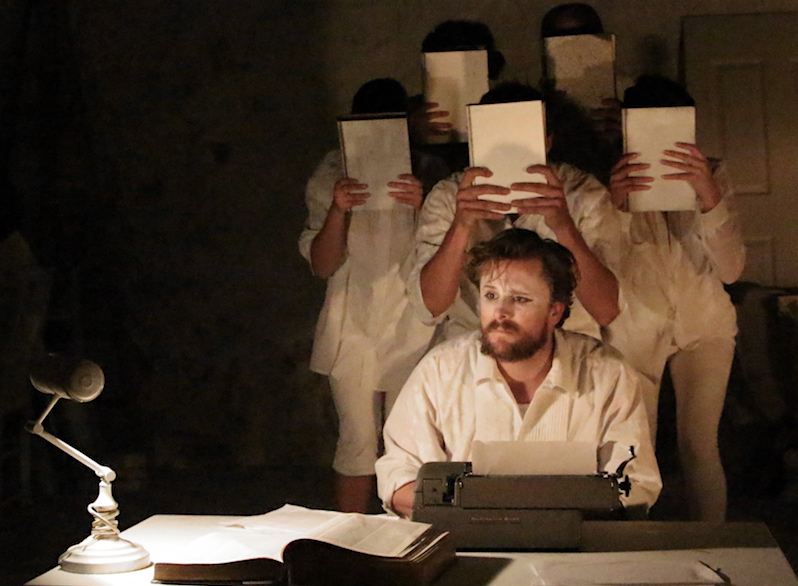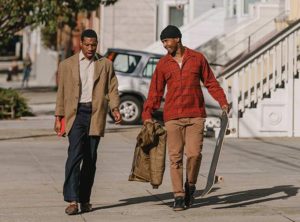‘Black Box’ Opera Reboots a Classic Form for a New Era
A hipper, grittier, more casual version of opera is attracting the interest of young audiences It could save the venerable art form, plagued by certain stereotypes, from a dusty fate A hipper, grittier, more casual version of opera is attracting the interest of young audiences. The Four Larks opera company staged its latest production of "The Temptation of St. Antony" in Los Angeles. (Jordan Riefe)
The Four Larks opera company staged its latest production of "The Temptation of St. Antony" in Los Angeles. (Jordan Riefe)
The Four Larks opera company staged its latest production of “The Temptation of St. Antony” in Los Angeles. (Jordan Riefe)
The sign on the door at 242 S. Broadway in downtown Los Angeles reads “Basic Flowers.” But inside you will find Four Larks, a small-scale opera company that stages productions in any abandoned site that will accommodate its players.
The former retail space was once, in fact, a flower shop but is now home to the company who is currently staging “The Temptation of St. Antony,” a modernist and surreal adaptation of the 1874 Gustave Flaubert novel. The production is emblematic of the medium’s new wave, black-box opera, which has sprung up across the country as the existing economic paradigm for traditional opera has begun to show cracks.
Originally staged in early 2015, “St. Antony” is described by Four Larks as a “junkyard” opera, a resourceful approach to the genre that entails using found items for props and making do with the barest of means. After it received exceptional reviews, the company decided to revive the piece through Sept. 11, with added music and, according to writer/director Mat Sweeney, a deeper interpretation of the text.
“The scale of work that we’re interested in making, it takes some time to develop,” explained Sweeney, who co-composed with Ellen Warkentine. “It’s been really useful to use the audience response from last time and then have the space to dream a little bit bigger and go through the roof on all of the various production components.”
Described by Flaubert himself as “the work of my life,” “St. Antony” was written over the course of his career but ignored by most critics and derided by many when finally published. It tells the story of Antony of Egypt, who tested his faith while living as a hermit in the desert. In Four Larks’ production he is visited by a series of temptations, including the Seven Deadly Sins, the Queen of Sheba, King Nebuchadnezzar, heretics, gods, monsters and personifications of love and death. Shoehorned into the backroom of the unremarkable downtown retail space, this epic, visionary piece somehow gains luster through its modest venue.
While Four Larks scrapes together productions in humble venues, venerable opera institutions stage classics to the tune of millions, financed by subscribers, donors and ticket prices as high as $475 at New York’s Metropolitan Opera, while premium tickets to “St. Antony” will run you $50.
The Met’s financial difficulties have been well chronicled in recent years, with General Manager Peter Gelb raising eyebrows when he proclaimed that opera is dying, then raising them still further by blaming union salaries for the company’s $2.8 million shortfall in 2014. Musicians responded by charging that it’s his irresponsible efforts to attract top-tier talent with new productions, rather than revivals, that were to blame. Relief arrived with the growing popularity of high-definition simulcasts to 2,000 cinemas in 70 countries around the world, helping to push last year’s surplus to $1 million.
Declaring bankruptcy in 2013, the New York City Opera closed after 70 years of what midcentury Mayor Fiorello La Guardia called “the people’s opera,” only to reopen earlier this year with ticket prices topping out at $310. Similarly, the San Diego Opera announced plans to close in 2014 but was saved only by cost-cutting and a fundraising blitz. Around the same time, black-box opera — low budget, small-venue original productions — began to proliferate.
The Wall Street Journal called the annual Prototype Festival in New York “the go-to spot for brilliantly produced new indie chamber opera.” Other cities include Seattle, home to Black Box Opera Theater, which opened its doors all the way back in 2006. Black Box Baroque in San Francisco was established in 2013, producing Handel’s trilogy, “Ariodante,” “Orlando” and, in spring, “Alcina” as part of the Berkeley Festival. Audiences tend to be hipsters and urban types in their 20s and 30s who favor a casual atmosphere.
“What The Industry is doing is really exciting,” Sweeney said about the site-specific opera company centered in L.A.’s Atwater Village. Its 2013 production of “Invisible Cities,” staged in downtown’s Union Station, was a Pulitzer Prize finalist. And last year’s “Hopscotch,” staged in limos and at various sites around downtown L.A., won wide recognition and changed perceptions of where musical performance could and should take place.
The recent world premiere of composer David Lang’s “Anatomy Theater,” part of L.A. Opera’s Off-Grand series, began with a public “hanging” in the lobby during a keg party. The body was then brought into the theater, where it lay naked on a slab before being dissected in front of the audience.
“It’s very much a chamber opera,” said Lang, who won a Pulitzer for his 2007 composition “The Little Match Girl Passion.” “This is a piece where you actually do need to be that close. It’s not going to be terrifying from a distance.”Originating as interstices during classic Roman plays and often preferred by Renaissance courtiers, opera became the aristocracy’s most popular form of performing arts. It was later embraced by the masses in the guise of opera buffa productions like Mozart masterpieces “The Marriage of Figaro” and “The Magic Flute.” As the first truly interdisciplinary art form, opera came of age in the 19th century with bel canto and later verismo (naturalistic) style in Italy, producing notable titles by masters including Verdi, Puccini and Rossini that still dominate the canon.
But where traditional opera generally raises issues and resolves them, works like “St. Antony” and “Anatomy Theater” offer no good guys or bad guys, nor do they reach solid conclusions on anything. Instead, audience members are left with questions about their own moral universe.
“We love our music, we love our institutions and we build these shrines, these beautiful theaters to do the best possible job we can to support the music that we love,” Lang observed. “Then we ask new people to fit into the old environments. There’s lots of music that’s made now that fits beautifully in these spaces. I’m not saying this is a rejection of that world. We need to ask composers where is the best place for you to do your music? It may not be that every idea that I have is meant for 4,000 seats at the Met.”
“Anatomy Theater” was presented by Beth Morrison Projects, sole contributor of chamber operas to the Off-Grand series. Her 2015 production “Dog Days” drew rave reviews in L.A. that year and in New York this year as part of the Prototype Festival. Off-Grand represents a step forward for the medium in that it is funded by a major opera company, the only black-box program of its kind in the U.S.
“I felt there was an emerging class of composers working in our world that are in their 20s, 30s and 40s who are interested in the art form of opera, and they have something to say about the short form and about the society we occupy,” L.A. Opera CEO Christopher Koelsch said. “To me it was a very fecund area of things that are happening in our world that are interesting, and I thought it was underrepresented.”
While L.A. Opera’s main stage mostly offers legacy productions, the company routinely includes at least one contemporary title, like Philip Glass’ “Akhnaten” (opening in November), no doubt in some part because of the surprise success of his “Einstein on the Beach” revival in 2013, a sellout over three nights despite its minimalist aesthetic, non-narrative structure and four-hour running time.
“There is kind of a reflexive prejudice against the art form because there’s an assumption that it’s for old rich white people who speak French. So there’s so many perceived barriers to entry. And in the end I wanted to break that down,” said Koelsch. “The audience is changing, the demographics are changing. We’re living in a fast-paced and dynamic world, and the charge for us is to be in dialogue with that change.”
A few blocks away at Four Larks, Sweeney is eager for dialogue. “We haven’t been able to get them [L.A. Opera] into our dirty warehouse yet,” he said, though he remains hopeful.
“It’s just awareness. I don’t think we’re on their radar at all.”
Your support matters…Independent journalism is under threat and overshadowed by heavily funded mainstream media.
You can help level the playing field. Become a member.
Your tax-deductible contribution keeps us digging beneath the headlines to give you thought-provoking, investigative reporting and analysis that unearths what's really happening- without compromise.
Give today to support our courageous, independent journalists.






You need to be a supporter to comment.
There are currently no responses to this article.
Be the first to respond.